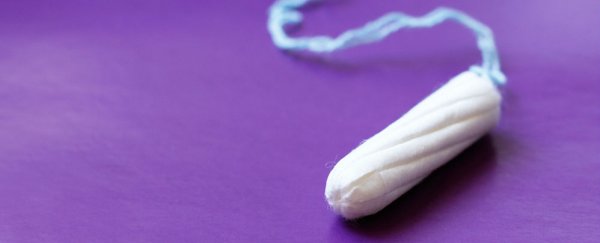Environmental engineers in the UK have been using tampons to help detect sewage seeping into waterways, and say their unusual tool is an affordable and effective option to help pinpoint sources of pollution.
The team from the University of Sheffield began looking at tampons because they are made from natural, untreated cotton, which can absorb tiny amounts of chemicals called optical brighteners, which are found in household products, such as detergents, toothpaste and shampoo.
These chemicals are essentially what keep your lemon-scented laundry looking super fresh, and your teeth sparkling. And importantly, they absorb ultraviolet light, causing them to glow in the dark.
The team used tampons to detect pollutants at several surface water outlets connected to local rivers and streams. This pollution, they say, is resulting from faulty sewer connections, which is leading to waste water from houses being prematurely discharged into waterways, rather than being sent to treatment plants.
"The main difficulty with detecting sewage pollution by searching for optical brighteners is finding cotton that does not already contain these chemicals. That's why tampons, being explicitly untreated, provide such a neat solution," said lead researcher David Lerner in a press release.
"Our new method may be unconventional – but it's cheap and it works."
The team is trying to locate housing developments where sewage pipes are incorrectly linked to the surface water network, resulting in pollution. This is difficult because the discharges are intermittent and often invisible.
"Often the only way to be sure a house is misconnected is through a dye test – putting dye down a sink or toilet and seeing where the coloured water appears in the sewer," said Lerner.
But he says this is impractical for water companies, as it's costly and time-consuming. He says the tampon test could offer a low-cost solution to detect pollution, and to work backwards to pinpoint faulty sections of the sewage infrastructure, or specific houses that need to be inspected.
In their lab experiments, they found that after submerging a tampon for five seconds in a solution containing just 0.01ml of detergent per litre of water - a concentration 300 times less than what's expected in waste water pipes - they were able to immediately identify optical brighteners. And these chemicals continued to be visible for up to 30 days afterward.
The team then headed outside. They suspending tampons for three days in 16 surface water outlets, which ran into streams and rivers in Sheffield, UK. When they tested the tampons under UV light afterward, nine of them glowed, confirming the presence of optical brighteners and sewage pollution.
With the help of a local water company, the team followed the pipe network back from four of the nine polluted outlets they identified. They dipped tampons at each of the manholes along the pipeline to try to figure out where the sewage was entering the system, and were able to locate several housing developments that needed a more detailed inspection.
Their results were published in the Water and Environment Journal.
The team is now conducting a larger-scale study with their glowing tampons. We wish them luck!
